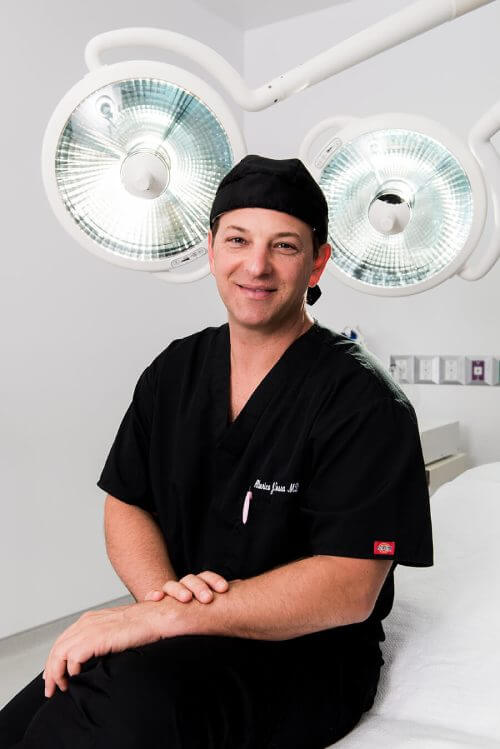Scarring is an expected result of any surgical procedure. However, in cosmetic surgery, scarring is meant to be as small, discreet, and hidden as possible. People who are interested in or undergo any facial plastic surgery are often more concerned about scarring. This is understandable since scars on or around the face are harder to hide than ones on the body. Let’s look at the question, “Does a brow lift scar?”
A brow lift does, of course, scar. However, most of the time, Dr. Sessa hides the incisions in the hairline, on the top of the head, and/or behind the ears. For most people, this adequately hides any scarring and the scars remain extremely discreet. If someone is prone to hair loss or is balding, a brow lift may not be ideal.
For a patient that is prone to raised scarring, this may complicate keeping the scars hidden, but if the hair is kept long enough, often it does not interfere. Dr. Sessa works to keep all brow lift scars as small and discreet as possible while also being hidden within the natural features of the face.
In this blog, we’ll break down the main types of brow lifts, what kinds of scars each technique leaves, how those scars heal over time, and the proven ways you and your surgeon can keep them virtually unnoticeable.
Do Brow Lifts Leave Scars?
A brow lift will, inevitably, leave scars. However, Dr. Sessa carefully places the incisions within the hairline, across the crown, or discreetly behind the ears so they blend with natural contours and remain barely noticeable once healed. Patients with significant hair thinning or male-pattern baldness should discuss alternate incision placement, as limited hair coverage can expose scars.
Those who tend to form hypertrophic or keloid scars face an added challenge, but combining strategic incision placement with post-operative scar-management tools, such as silicone sheeting, topical gels, and laser therapy, usually keeps marks subtle.
Different types of brow lift procedures
Brow lifts are not a single-technique surgery, and each approach uses its own incision pattern, which in turn determines where a scar will form. Below, we will discuss different brow-lift methods and the scars they leave behind.
Endoscopic Brow Lift
A minimally invasive option that lifts the brow with an endoscope (tiny camera) and specialized instruments.
- Incision placement: Five or six ½-inch cuts hidden several centimeters behind the hairline.
- Resulting scars: Short, fine lines completely camouflaged by surrounding hair once healed.
Coronal (Traditional) Brow Lift
Offers the most dramatic lift by removing excess forehead skin through a single, ear-to-ear incision.
- Incision placement: A long cut running across the crown, roughly 2–3 inches behind the hairline.
- Resulting scars: A continuous scar that generally hides well in dense hair; risk of widening if you routinely wear tight hairstyles.
Hairline (Pre-trichial) Brow Lift
Ideal for patients with a high forehead who want both lift and a slightly lower hairline.
- Incision placement: Along the anterior hairline, following natural follicle irregularities to disguise the cut.
- Resulting scars: A fine, zig-zag scar that blends into new hair growth; may be faintly visible in strong overhead lighting.
Temporal (Lateral) Brow Lift
Targets sagging at the outer third of the brow and crow’s feet without changing the central forehead.
- Incision placement: Two 1-inch cuts just behind the temples within the hair-bearing scalp.
- Resulting scars: Short, well-hidden lines that rarely widen because the temporal scalp is relatively immobile.
Direct (Mid-Brow) Brow Lift
Reserved for severe brow droop in patients who prioritize lift over scar location (often older men with thick brow hair).
- Incision placement: Immediately above each eyebrow, following the natural arch.
- Resulting scars: Thin lines that settle into the upper brow crease; visibility depends on individual hair density.
Regardless of the technique you choose, strategic incision placement combined with diligent aftercare will help keep brow-lift scars soft, flat, and virtually invisible.
Additional reads: What Are The Risks Of A Brow Lift?
What Do Brow Lift Scars Look Like as They Heal?
Scars pass through multiple phases: early inflammation, active rebuilding, and long-term maturation. Color, thickness, and texture all improve steadily, especially when you protect the incision and follow your surgeon’s care plan.
Typical healing timeline
- Week 1: Incision edges look red and slightly raised; the surrounding skin is swollen or bruised. Keep the area clean, dry, and lightly covered as instructed.
- Week 2: Sutures or staples are usually removed. Redness persists, but swelling has largely subsided; itching is common.
- Weeks 3–4: Color fades from bright red to pink, and the line begins to flatten. Most patients are cleared to resume light exercise and can camouflage the scar with makeup.
- Months 2–3: Scar is pale pink or light brown, thinner, and smoothly integrated with nearby skin or hairline. Minor numbness or firmness may linger.
- Month 6: In many cases, the scar is flat, soft, and close to your natural skin tone, typically hidden entirely by hair or brow contours.
- One year: Final maturation. The line is usually barely visible unless inspected closely, though individual pigment and genetics can affect the exact outcome.
Quick scar-care cheat sheet
- Silicone gel or sheets after the incision closes to flatten and fade.
- Daily SPF 30+ to stop the scar from darkening.
- Light massage from week 3 (if your surgeon okays it) to smooth collagen.
- Targeted treatments like laser or microneedling for stubborn scars.
Do Non-Surgical Brow Lifts Leave Scars?
A non-surgical brow lift is any technique that raises the brows without incision—most commonly neuromodulator injections (often called a “Botox brow lift”), but it can also include dermal fillers, PDO threads, or energy-based skin-tightening devices. Because all of these methods rely on needles or external energy rather than scalpels, they create no surgical scars—just tiny injection or probe marks that disappear within hours to a few days. If you want a subtle elevation with minimal lasting marks and minimal downtime, a non-surgical option like a Botox brow lift is an excellent place to start.
Is a brow lift right for you?
Schedule a private consultation with Dr. Sessa at Sarasota Surgical Arts to review your goals, choose the best incision approach for your hairline and skin type, and map out a customized scar-prevention plan. To learn more and book your visit, call 941-923-1735 or connect with us online via live chat, our contact form, or the Price Simulator.
FAQs
How long do brow lift scars take to fade?
Scars usually appear red or pink for the first few weeks, then soften and lighten noticeably by 3–4 months, and reach their final, barely visible state around 9–12 months, sometimes sooner with proper scar care.
Will the scars be visible with short hair?
Scars are generally not visible since most incisions are placed 1–3 cm behind the hairline or in the brow crease, even short hair can hide them well.
Can I cover scars with makeup?
You can use non-comedogenic concealer or mineral makeup to cover any residual redness once the skin is fully healed and the sutures are removed (usually after 10–14 days).






